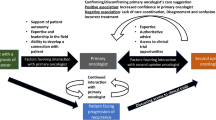Abstract
Purpose
Increasingly, patient- and family-centered care (PFCC) is recognized as a valuable component of healthcare reform with rich opportunities for improvement within oncology. Shifting toward PFCC requires physician buy-in; however, research examining their perspectives on PFCC is lacking. We sought to explore oncologists’ perspectives on PFCC to identify factors that influence their ability to practice PFCC.
Methods
We conducted semi-structured interviews with 18 oncologists (8 radiation, 4 medical, 4 surgical, 2 hematologist-oncologists) at a single Canadian academic cancer institution. Interview data were analyzed using thematic analysis and principles drawn from grounded theory. Subsequently, focus groups consisting of the interviewed participants were facilitated to confirm and elaborate on our findings. Constant comparisons were used to identify recurring themes.
Results
Three dominant themes emerged. First, physicians displayed cautious engagement in their approach to PFCC. Collectively, participants understood the general principles of PFCC. However, there was a limited understanding of the value, implications, and motivation for improving PFCC which may create reluctance with physician buy-in. Second, both individual and system barriers to practicing PFCC were identified. A lack of physician acknowledgement and engagement and competing responsibilities emerged as provider-level challenges. System barriers included impaired clinic workflow, physical infrastructure constraints, and delays in access to care. Third, physicians were able to identify existing and potential PFCC behaviors that were feasible within existing system constraints.
Conclusions
Advancing PFCC will require continued physician education regarding the value of PFCC, acknowledgement and preservation of effective patient- and family-centered strategies, and creative solutions to address the system constraints to delivering PFCC.

Similar content being viewed by others
References
Institute for Healthcare Improvement: Patient-and-family-centered care: overview. http://www.ihi.org/Topics/PFCC/Pages/Overview.aspx. Accessed 14 Dec 2015
Institute for Patient- and Family-Centered Care: Frequently asked questions: what is patient- and family-centered care? http://www.ipfcc.org/faq.html. Accessed 14 Dec 2015
Institute of Medicine Committee on Quality of Health Care in America (2001) Crossing the quality chasm: a new health system for the twenty-first century. National Academies Press, Washington, DC
Canadian Medical Association (2010) Health care transformation in Canada: Change that Works, Care that Lasts, Ottawa, Canada
World Health Organization (2008) Regional Office for Europe: The Tallin Charter: health systems for health and wealth, Denmark
Staniszewska S, Adams J, Carr E et al (2012) Patient experience in adult NHS services: improving the experience of care for people using adult NHS services. National Institute for Health and Clinical Excellence, London, UK
Health Affairs Blog: Patient-Centered Care: what it means and how to get there. http://healthaffairs.org/blog/2012/01/24/patient-centered-care-what-it-means-and-how-to-get-there. Accessed 15 December 2015
Frampton S, Guastello S, Brady C, et al. (2008) Patient-centered care improvement guide. The Picker Institute, Camden
ASCO Connection: Collective Wisdom: patient-centered care and research. https://connection.asco.org/commentary/collective-wisdom-patient-centered-care-and-research. Accessed 15 December, 2015
Biddy R, Griffin C, Johnson N, et al. (2015) A quality initiative endorsed by Cancer Care Ontario in partnership with the program in evidence-based care (PEBC): person-centered care guideline. Cancer Care Ontario, Toronto
Black C, Mooney D, Peterson S (2014) Patient experiences with outpatient cancer care in British Columbia, 2012/2013. UBC Centre for Health Services and Policy Research. Vancouver, British Columbia
Chassin MR, Galvin RW (1998) The urgent need to improve health care quality. Institute of Medicine National Roundtable on health care quality. JAMA 280:1000–1005
Charmaz K (2014) Constructing grounded theory, 2nd edn. Sage publications Ltd, Thousand Oaks
Berwick DM (1999) What ‘patient-centered’ should mean: confessions of an extremist. Health Aff 28:555–565
Stewart M (1995) Effective physician-patient communication and health outcomes: a review. CMAJ 152:1423–1433
Bertakis KD, Azari R (2011) Patient-centered care is associated with decreased health care utilization. J Am Board Fam Med 24:229–239
Isaac I, Zaslavsky AM, Cleary PD, et al. (2010) The relationship between patients’ perception of care and measures of hospital quality and safety. Health Serv Res 45:1024–1040
Lee DS, Tu JV, Chong A, et al. (2008) Patient satisfaction and its relationship with quality and outcomes of care after acute myocardial infarction. Circulation 118:1938–1945
Mohanty S, Kinnier CV, Bilimoria KY (2015) Patient satisfaction, outcomes, and the need for cancer-specific quality metrics. J Natl Cancer Inst 107:438
Visser M, Deliens L, Houttekier D (2014) Physician-related barriers to communication and patient- and family-centred decision-making towards the end of life in intensive care: a systematic review. Crit Care 18:604
Shankar LR, Wolf JA (2012) Physician perspectives on patient experience. The Beryl Institute, Bedford
Health Affairs: Health Policy Briefs: physician compare. http://www.healthaffairs.org/healthpolicybriefs/brief.php?brief_id=131. Accessed 15 Dec 2015
Association of American Medical Colleges: AAMC Reporter: Viewpoint: creating a patient-centered culture. https://www-aamcorg.proxy1.lib.uwo.ca/newsroom/reporter/june2014/384810/viewpoint-patient-centered.html. Accessed 15 Dec 2015
Acknowledgments
The authors acknowledge Carol Martin and Kimberly Trudgeon for their hard work in preparing the interview transcripts.
Author information
Authors and Affiliations
Corresponding author
Ethics declarations
Research ethics board approval was obtained at our institution, and all interviewees provided consent to audio recording of the interviews.
Conflict of interest
None.
We will share study data upon request.
Rights and permissions
About this article
Cite this article
Nguyen, T.K., Bauman, G.S., Watling, C.J. et al. Patient- and family-centered care: a qualitative exploration of oncologist perspectives. Support Care Cancer 25, 213–219 (2017). https://doi.org/10.1007/s00520-016-3414-9
Received:
Accepted:
Published:
Issue Date:
DOI: https://doi.org/10.1007/s00520-016-3414-9




